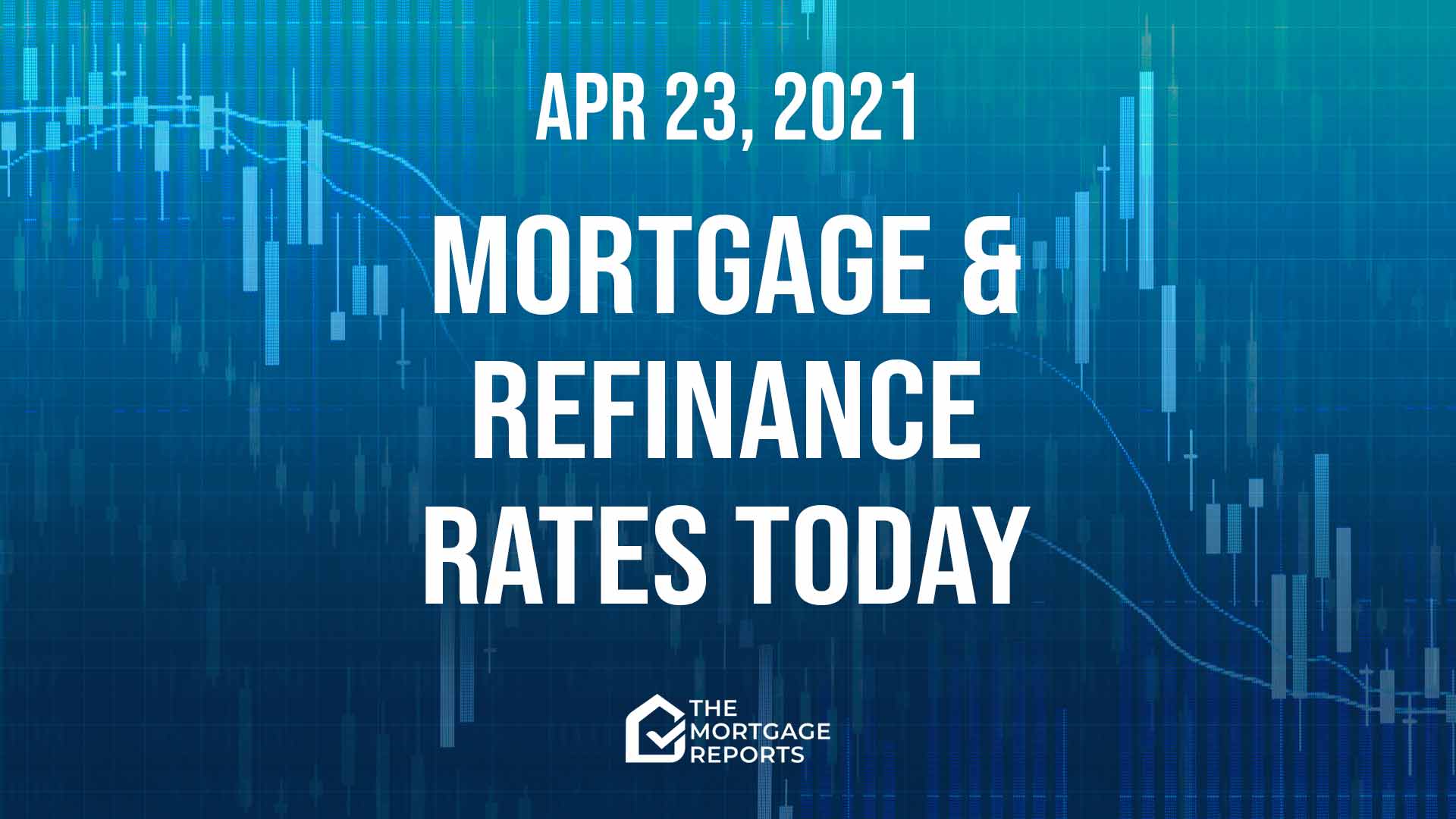
Today’s mortgage and refinance rates
Average mortgage rates edged lower yesterday. They’d looked likely to rise earlier in the day. But they changed course during the afternoon on concerns about future tax rates.
Early movements in markets suggest mortgage rates might hold steady today or just edge either side of the neutral line. Because investors seem to be in two minds. As this morning’s Wall Street Journal put it: “Sentiment has wavered between concerns about fresh waves of Covid-19 infections around the world and optimism prompted by promising economic data and strong corporate earnings.”
Find and lock a low rate (Apr 27th, 2021)Current mortgage and refinance rates
| Program | Mortgage Rate | APR* | Change |
|---|---|---|---|
| Conventional 30 year fixed | |||
| Conventional 30 year fixed | 2.983% | 2.988% | Unchanged |
| Conventional 15 year fixed | |||
| Conventional 15 year fixed | 2.125% | 2.242% | -0.06% |
| Conventional 20 year fixed | |||
| Conventional 20 year fixed | 2.719% | 2.81% | -0.03% |
| Conventional 10 year fixed | |||
| Conventional 10 year fixed | 1.906% | 2.058% | -0.03% |
| 30 year fixed FHA | |||
| 30 year fixed FHA | 2.746% | 3.403% | -0.01% |
| 15 year fixed FHA | |||
| 15 year fixed FHA | 2.478% | 3.063% | -0.02% |
| 5 year ARM FHA | |||
| 5 year ARM FHA | 2.5% | 3.207% | Unchanged |
| 30 year fixed VA | |||
| 30 year fixed VA | 2.375% | 2.547% | Unchanged |
| 15 year fixed VA | |||
| 15 year fixed VA | 2.25% | 2.571% | Unchanged |
| 5 year ARM VA | |||
| 5 year ARM VA | 2.5% | 2.386% | Unchanged |
| Rates are provided by our partner network, and may not reflect the market. Your rate might be different. Click here for a personalized rate quote. See our rate assumptions here. | |||
COVID-19 mortgage updates: Mortgage lenders are changing rates and rules due to COVID-19. To see the latest on how coronavirus could impact your home loan, click here.
Should you lock a mortgage rate today?
If I were still floating my rate, I’d do two things right away. First, call my lender to make sure I can lock almost instantly whenever I want to do so. And secondly, I’d start to monitor mortgage rates very closely, at least daily.
If I didn’t want the chore of monitoring, I’d lock now — even though rates have been moving lower. Because they could rise quickly when they resume their upward trend. Of course, I can’t be certain of that resumption. But read on for the reasons why I’m close to sure.
So, for now, my personal rate lock recommendations remain:
- LOCK if closing in 7 days
- LOCK if closing in 15 days
- LOCK if closing in 30 days
- LOCK if closing in 45 days
- LOCK if closing in 60 days
But I don’t claim perfect foresight. And your personal analysis could turn out to be as good as mine — or better. So you might choose to be guided by your instincts and your personal tolerance for risk.
Market data affecting today’s mortgage rates
Here’s a snapshot of the state of play this morning at about 9:50 a.m. (ET). The data, compared with roughly the same time yesterday, were:
- The yield on 10-year Treasurys held steady at 1.56% (Neutral for mortgage rates.) More than any other market, mortgage rates normally tend to follow these particular Treasury bond yields, though less so recently
- Major stock indexes were mostly higher on opening. (Bad for mortgage rates.) When investors are buying shares they’re often selling bonds, which pushes prices of those down and increases yields and mortgage rates. The opposite happens when indexes are lower
- Oil prices rose to $61.60 from $61.26 a barrel. (Neutral for mortgage rates*.) Energy prices play a large role in creating inflation and also point to future economic activity.
- Gold prices inched up to $1,786 from $1.785 an ounce. (Neutral for mortgage rates*.) In general, it’s better for rates when gold rises, and worse when gold falls. Gold tends to rise when investors worry about the economy. And worried investors tend to push rates lower
- CNN Business Fear & Greed index — Fell to 56 from 60 out of 100. (Good for mortgage rates.) “Greedy” investors push bond prices down (and interest rates up) as they leave the bond market and move into stocks, while “fearful” investors do the opposite. So lower readings are better than higher ones
Caveats about markets and rates
Before the pandemic and the Federal Reserve’s interventions in the mortgage market, you could look at the above figures and make a pretty good guess about what would happen to mortgage rates that day. But that’s no longer the case. We still make daily calls. And are usually right. But our record for accuracy won’t achieve its former high levels until things settle down.
So use markets only as a rough guide. Because they have to be exceptionally strong or weak to rely on them. But, with that caveat, so far mortgage rates today look likely to be unchanged or barely changed. Just be aware that intraday swings (when rates change direction during the day) are a common feature right now.
Find and lock a low rate (Apr 27th, 2021)
Important notes on today’s mortgage rates
Here are some things you need to know:
- Typically, mortgage rates go up when the economy’s doing well and down when it’s in trouble. But there are exceptions. Read ‘How mortgage rates are determined and why you should care
- Only “top-tier” borrowers (with stellar credit scores, big down payments and very healthy finances) get the ultralow mortgage rates you’ll see advertised
- Lenders vary. Yours may or may not follow the crowd when it comes to daily rate movements — though they all usually follow the wider trend over time
- When daily rate changes are small, some lenders will adjust closing costs and leave their rate cards the same
- Refinance rates are typically close to those for purchases. But some types of refinances are higher following a regulatory change
So there’s a lot going on here. And nobody can claim to know with certainty what’s going to happen to mortgage rates in coming hours, days, weeks, or months.
Are mortgage and refinance rates rising or falling?
Today and soon
Mortgage rates have been falling this month for various reasons. But the main one currently is that investors are concerned about the effects of COVID-19 on the global economy.
True, they have few grounds for concern when it comes to the domestic economy. Nearly all the recent economic data here have been exceptionally good. But continued US growth depends to some extent on global trade. And some key partners — most noticeably India — are now experiencing serious COVID-19 issues.
But how long will those issues remain? So far 525 million people worldwide have had at least one vaccine dose. And the rate of new vaccinations is snowballing, especially among key trading partners. On April 1, only 349 million people had received an injection, according to Our World in Data. In India, 110 million people had been vaccinated by April 21, compared with 59 million on April 1.
So will the pandemic in foreign countries strangle our nascent domestic boom? Your guess is as good as mine. But I doubt it.
And, if I’m right, higher mortgage rates are all-but inevitable. Because booms pretty much always bring higher rates. What nobody knows is if and when investors will regain their nerve.
For more background on my wider thinking, read our latest weekend edition, which is published every Saturday soon after 10 a.m. (ET).
Recently
Over much of 2020, the overall trend for mortgage rates was clearly downward. And a new, weekly all-time low was set on 16 occasions last year, according to Freddie Mac.
The most recent weekly record low occurred on Jan. 7, when it stood at 2.65% for 30-year fixed-rate mortgages. But then the trend reversed and rates rose.
However, those rises paused in April. And Freddie’s Apr. 22 report puts that weekly average at 2.97% (with 0.7 fees and points), down from the previous week’s 3.04%.
Expert mortgage rate forecasts
Looking further ahead, Fannie Mae, Freddie Mac and the Mortgage Bankers Association (MBA) each has a team of economists dedicated to monitoring and forecasting what will happen to the economy, the housing sector and mortgage rates.
And here are their current rates forecasts for the remaining quarters of 2021 (Q2/21, Q3/21, Q4/21) and the first quarter of 2022 (Q1/22).
The numbers in the table below are for 30-year, fixed-rate mortgages. Freddie’s were updated on April 14, Fannie’s on April 12 and the MBA’s on April 22.
| Forecaster | Q2/21 | Q3/21 | Q4/21 | Q1/22 |
| Fannie Mae | 3.2% | 3.3% | 3.4% | 3.5% |
| Freddie Mac | 3.2% | 3.3% | 3.4% | 3.5% |
| MBA | 3.4% | 3.6% | 3.7% | 3.9% |
However, given so many unknowables, the current crop of forecasts might be even more speculative than usual.
Find your lowest rate today
Some lenders have been spooked by the pandemic. And they’re restricting their offerings to just the most vanilla-flavored mortgages and refinances.
But others remain brave. And you can still probably find the cash-out refinance, investment mortgage or jumbo loan you want. You just have to shop around more widely.
But, of course, you should be comparison shopping widely, no matter what sort of mortgage you want. As federal regulator the Consumer Financial Protection Bureau says:
Verify your new rate (Apr 27th, 2021)Shopping around for your mortgage has the potential to lead to real savings. It may not sound like much, but saving even a quarter of a point in interest on your mortgage saves you thousands of dollars over the life of your loan.



